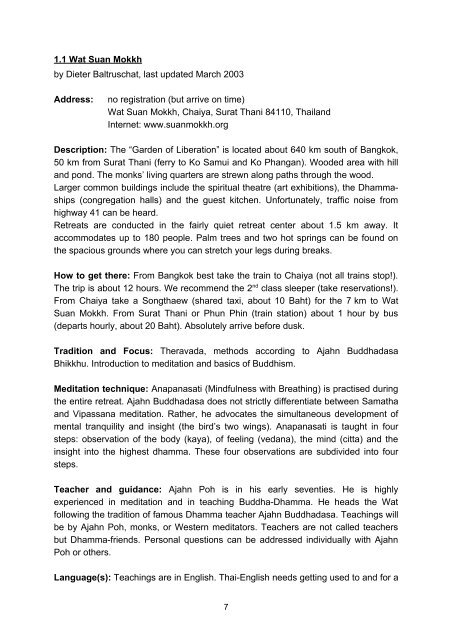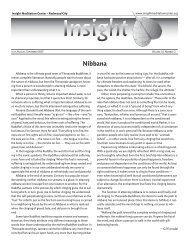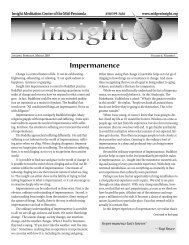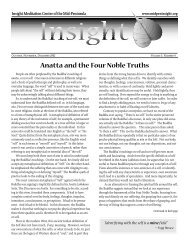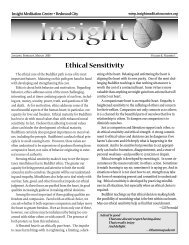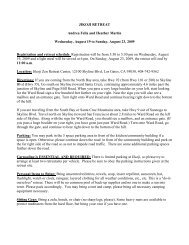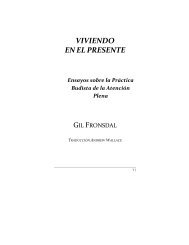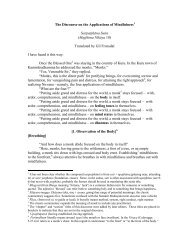Meditation in Southeast Asia - Insight Meditation Center
Meditation in Southeast Asia - Insight Meditation Center
Meditation in Southeast Asia - Insight Meditation Center
You also want an ePaper? Increase the reach of your titles
YUMPU automatically turns print PDFs into web optimized ePapers that Google loves.
1.1 Wat Suan Mokkh<br />
by Dieter Baltruschat, last updated March 2003<br />
Address: no registration (but arrive on time)<br />
Wat Suan Mokkh, Chaiya, Surat Thani 84110, Thailand<br />
Internet: www.suanmokkh.org<br />
Description: The “Garden of Liberation” is located about 640 km south of Bangkok,<br />
50 km from Surat Thani (ferry to Ko Samui and Ko Phangan). Wooded area with hill<br />
and pond. The monks’ liv<strong>in</strong>g quarters are strewn along paths through the wood.<br />
Larger common build<strong>in</strong>gs <strong>in</strong>clude the spiritual theatre (art exhibitions), the Dhammaships<br />
(congregation halls) and the guest kitchen. Unfortunately, traffic noise from<br />
highway 41 can be heard.<br />
Retreats are conducted <strong>in</strong> the fairly quiet retreat center about 1.5 km away. It<br />
accommodates up to 180 people. Palm trees and two hot spr<strong>in</strong>gs can be found on<br />
the spacious grounds where you can stretch your legs dur<strong>in</strong>g breaks.<br />
How to get there: From Bangkok best take the tra<strong>in</strong> to Chaiya (not all tra<strong>in</strong>s stop!).<br />
The trip is about 12 hours. We recommend the 2 nd class sleeper (take reservations!).<br />
From Chaiya take a Songthaew (shared taxi, about 10 Baht) for the 7 km to Wat<br />
Suan Mokkh. From Surat Thani or Phun Ph<strong>in</strong> (tra<strong>in</strong> station) about 1 hour by bus<br />
(departs hourly, about 20 Baht). Absolutely arrive before dusk.<br />
Tradition and Focus: Theravada, methods accord<strong>in</strong>g to Ajahn Buddhadasa<br />
Bhikkhu. Introduction to meditation and basics of Buddhism.<br />
<strong>Meditation</strong> technique: Anapanasati (M<strong>in</strong>dfulness with Breath<strong>in</strong>g) is practised dur<strong>in</strong>g<br />
the entire retreat. Ajahn Buddhadasa does not strictly differentiate between Samatha<br />
and Vipassana meditation. Rather, he advocates the simultaneous development of<br />
mental tranquility and <strong>in</strong>sight (the bird’s two w<strong>in</strong>gs). Anapanasati is taught <strong>in</strong> four<br />
steps: observation of the body (kaya), of feel<strong>in</strong>g (vedana), the m<strong>in</strong>d (citta) and the<br />
<strong>in</strong>sight <strong>in</strong>to the highest dhamma. These four observations are subdivided <strong>in</strong>to four<br />
steps.<br />
Teacher and guidance: Ajahn Poh is <strong>in</strong> his early seventies. He is highly<br />
experienced <strong>in</strong> meditation and <strong>in</strong> teach<strong>in</strong>g Buddha-Dhamma. He heads the Wat<br />
follow<strong>in</strong>g the tradition of famous Dhamma teacher Ajahn Buddhadasa. Teach<strong>in</strong>gs will<br />
be by Ajahn Poh, monks, or Western meditators. Teachers are not called teachers<br />
but Dhamma-friends. Personal questions can be addressed <strong>in</strong>dividually with Ajahn<br />
Poh or others.<br />
Language(s): Teach<strong>in</strong>gs are <strong>in</strong> English. Thai-English needs gett<strong>in</strong>g used to and for a<br />
7


